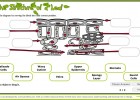Cargando...
Recursos educativos
-
Nivel educativo
-
Competencias
-
Tipología
-
Idioma
-
Tipo de medio
-
Tipo de actividad
-
Destinatarios
-
Tipo de audiencia
-
Creador
Lo más buscado
- Juegos para aprender
- Arte prerrománico
- Contaminación acustica
- Juegos numéricos
- Leonardo da Vinci
- Repaso de historia
- Descargar ejercicios de geometría
- experimentos para niños
- imprimir ejercicios de matemáticas
- Descargar ejercicios de matemáticas
- juegos lectoescritura
- Desarrollo de habilidades
- Nutrición infantil
- Descargar ejercicios de ortografía
- imágenes lengua
-

Learn to discover the starch in a leaf and see how stomata function
EduBook Organización
- 2453 visitas
1. Objective: to discover if starch is present in a leaf Plants store the glucose made during photosynthesis as starch. To test this hypothesis, a leaf will be examined for the presence of starch.…
-

Check. What plants need
EduBook Organización
- 2390 visitas
Remember what you have studied in this section and answer the questions: Define autotroph and heterotroph. Ask a classmate to define these words: nutrition, photosynthesis, carbon dioxide, a root, a…
-

The structure of a leaf
Tiching explorer Organización
- 3243 visitas
In this exercise we are asked to label the different parts on a cross section diagram of a leaf. Students may tell what fuction each part has in the photosynthesis. We can practice specific vocabulary…
-

Final evaluation 8 - The Diversity of Life
EduBook Organización
- 2116 visitas
Find the false sentences and correct them: All algae are green in colour. All algae make their food through photosynthesis. All algae are multicellular organisms. All algae live in the sea. Algae…
-

Unit 9: The Diversity of Life
EduBook Organización
- 1596 visitas
Algae (n): unicellular or multicellular organisms capable of photosynthesis. biodiversity (n): the degree of difference between living organisms. cilia (n): short threadlike structures that help some…
-

The carbon cycle
EduBook Organización
- 1541 visitas
The carbon present in living things comes from atmospheric carbon dioxide. Plants and algae take in carbon dioxide through photosynthesis. They use it to make the biomolecules which they need to grow.…
-

The formation of the Earth atmosphere
EduBook Organización
- 1259 visitas
In the beginning, our planet had no atmosphere. As the Earth cooled, various gases were produced. These gases formed the first atmosphere. Oxygen appeared when the first plants began to produce oxygen…
-

Answer. Plants (4)
EduBook Organización
- 1176 visitas
Find the false sentences and correct them: Seeds can only survive if the conditions of temperature and humidity are suitable. Seeds are made up of an embryo, the nutritional reserves in the cotyledon…
-

Animal nutrition
EduBook Organización
- 14378 visitas
Animals are heterotrophic organisms; they cannot make the organic material they need to eat. They can get organic material from other animals and from plants. Plants are the only living things that can…
-

Before you start - Animal nutrition
EduBook Organización
- 7446 visitas
Animals are heterotrophic organisms; they cannot make the organic material they need to eat. They can get organic material from other animals and from plants. Plants are the only living things that can…
Te estamos redirigiendo a la ficha del libro...













